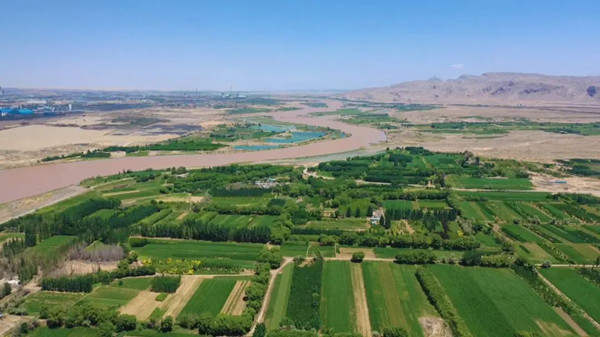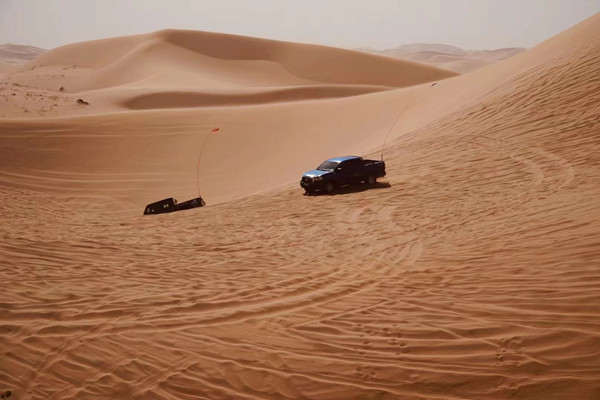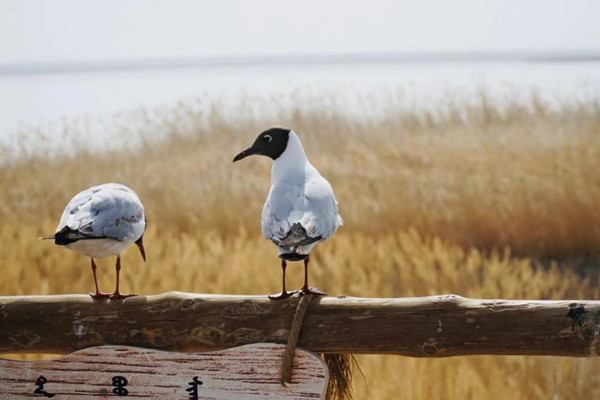Window into Alshaa's desert tourism
- Updated: 2023-05-08

Desertified land turns into fertile oasis. [Photo/WeChat account of Alshaa Broadcasting and TV Station]
Afforestation efforts
As the westernmost league in North China's Inner Mongolia autonomous region, Alshaa has an area as large as 270,000 square kilometers (104,247 square miles).
However, only 6 percent of the area in the league's jurisdiction is suitable for human production and living. It is run through by the country's third largest desert Badain Jaran, the fourth largest desert Tengger, and the Ulan Buh Desert.
How to develop such a place with a harsh natural environment has become a critical task confronted by the local government.
A practical approach for promoting tourism is to capitalize on the abundant resources of the desert while simultaneously engaging in afforestation efforts.
Since the 1980s, Alshaa has continuously carried out aerial seeding afforestation on the eastern edge of the Tengger Desert and the southwestern edge of the Ulan Buh Desert.
By the end of 2021, Alshaa had 89.4 million mu (5.96 million hectares) of desertified land under control, completed 939,000 mu of afforestation in crucial areas, and planted 22.63 million trees.
In 2022 alone, Alshaa completed an afforestation of 42,266 hectares.
By the end of last year, the forest area of the league exceeded 2 million hectares, with a forest coverage rate of 8.37 percent. Meanwhile, another 670,000 hectares of grassland were planted or protected, contributing to a grassland vegetation coverage of 22.9 percent.
Up to now, a model for ecological treatment that integrates forest management, aerial sowing afforestation, and artificial afforestation has been established.
To further build a green "Great Wall" to shield ecological safety, more green projects are now underway.
According to data provided by the Forestry and Grassland Bureau of the league, the initial stage of the Inner Mongolia Western Desert Comprehensive Management Project commenced in April of this year.
Plans are for the league to fix sand, plant grass and trees, and restore degraded forests in its Alshaa Left Banner, Alshaa Right Banner and Ejine Banner, Shuangjingtan Ecological Migration Demonstration Zone, and Ulan Buh Ecological Sand Industry Demonstration Zone.
Recently, Inner Mongolia Development and Reform Commission approved the second phase of the project.
According to the plan, a total investment of 280 million yuan ($40.29 million) is scheduled to be used to plant 700,000 mu of artificial shrubs, including 370,000 mu in the Alshaa Left Banner and 200,000 mu in the Alshaa Right Banner. The construction period is from April 2023 to December 2024.

Cars roar along the track in the Tengger Desert. [Photo provided to chinadaily.com.cn]
Desert tourism
Alshaa has been increasing its investment in the cultural and tourism industry, despite its green efforts. In order to become an internationally renowned tourist destination, the city has introduced ten measures to enhance the quality of its cultural and tourism industry.
In 2022, Alshaa received 3.39 million domestic tourist visits and achieved a tourism revenue of 3.25 billion yuan in total.
During this year's 5-day International Labor Day holiday, the league held an array of activities including the Alshaa Moto Festival, a music festival and food fairs, Ejine's camel cultural tourism activities, and the 11th Asia-Pacific Business School Desert Challenge.
The National Self-driving Camping Tourism Development Conference opened in the Dream Desert Park in Alshaa League, on April 28, unveiling the northern league's ambition in the sector.
The 2023 National Self-driving Camping Tourism Development Forum kicked off on April 30, inviting six scholars, experts and guests to give keynote lectures on the development and future direction of the sector.
Liu Min, professor of the Tourism College of Beijing Union University, said "Difference creates tourism, and the desert can sell loneliness."
Liu stated that Alshaa has rich desert resources compared with other places and unique advantages in the development of desert tourism.
"The deserts, away from the fast-paced life of the city, can provide tourists with long-lost tranquility, which has huge appeal to city dwellers," she added.
"The epidemic has once again strengthened people's awareness of health and safety, as well as rational and scientific governance," said Cai Jiacheng, a special researcher at the Tourism Research Center of the Chinese Academy of Social Sciences.
Cai suggests that self-driving tours will become increasingly popular as a safe and convenient way for travelers to enjoy domestic vacations while minimizing the risk of infection during the post-pandemic period.
In the first four days of this year's International Labor Day holiday, a total of 379,600 tourist visits were made to Alshaa.
Meng Chao, from the National School of Development at Peking University, described his participation in the 11th Asia-Pacific Business School Desert Challenge as both a personal challenge and a chance to appreciate the breathtaking scenery of Alshaa.

Migratory birds pictured in Juyanhai Scenic Area [Photo provided to chinadaily.com.cn]
Juyanhai ecological restoration
In the depth of the gobi area in Ejine Banner in Alshaa League lies the Juyanhai Scenic Area.
Since the 1950s and 1960s, the amount of water discharged from the Heihe River has decreased, the river course has been seriously cut off, the groundwater level of the Ejine oasis has dropped, and the land has gradually become desertified.
With further research and continuous efforts made in solving the problems the area's facing in its ecological environment and water resources, as of 2019, East Juyanhai has stored water for 17 consecutive years, and the water area has remained at about 44 square kilometers. The ecology of the Ejine oasis is seeing recovery.
The current wetland area of Juyanhai is 58.82 square kilometers, the water area is maintained at about 40 square kilometers all year round.
With the restoration of the ecology, the types of vegetation in Juyanhai have increased, providing sufficient food for birds. The lush reed fields provide an ideal habitat for migratory birds, which form a unique scenery during the migration season.
According to statistics, the migratory birds recorded in the Juyanhai Scenic Area mainly include mute swans, whooper swans, egrets, herons, gray geese, red-billed gulls, red shelducks, and red-billed pochards.


